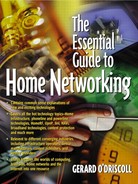THE CRITERIA FOR TESTING POWERLINE SOLUTIONS
Evaluating the overall effectiveness of a given powerline solution can be difficult, considering the multitude of technical obstacles and different possible approaches for overcoming each of them. The following three criteria are typically used to benchmark the technical performance of a given powerline communications solution. Together, the bit error rates (BER), the throughput levels, and the latency levels of a given solution provide a solid benchmark for its effectiveness.
Technical Criteria
Bit Error Rate (BER)
The BER quantifies the amount of data lost between the transmitter and receiver when the signal is propagated across the line. BER measurements are particularly important in powerline networks where the harsh noise environment can cause considerable loss of data packets. The BER figures provides a useful measure of the performance of different coding techniques and serve as a good initial indicator of data throughput.[5]
[5] Although the effective and nominal throughput levels are typically a function of the Bit Error Rate levels, the level of correlation between them can vary with different technologies. For this reason they are identified as separate criteria, although they tend to be highly interdependent.
Throughput Levels
Nominal and effective bit rates provide an indication of a technology's overall performance in normal to noisy environments. Because the powerline is inherently so noisy, it is inevitable that the throughput varies with the characteristics of the environment. For example, when a blender (or other brush motor device) is being used it will inject significant noise onto the line, degrading the effective throughput of data. Some technologies might be completely unable to transmit data in such an environment, effectively crashing the network, while others might be able to transmit data consistently, but at much lower throughput levels.[6] This issue is considerable if you extend the blender example to all of the other devices in a home, like hair dryers, heaters, and stereos, that consumers will use without concern for their effect on the performance of the network. For this reason, both nominal and effective bit rate measurements together provide a true assessment of a technology's overall functional performance under both the ideal and noisy environments of the real world.
[6] One of the key requirements for a home network is "dial tone" quality, whereby the network never crashes. Instead the network performance will "degrade gracefully" and bandwidth will scale down in the face of noise offenders. Thus, a high-speed network with a nominal throughput of 10 Mbps must be able to scale down to a lower effective throughput (perhaps to a minimum of 1 Mbps), which could still manage high-priority traffic even with significant environment noise. Quality of Service (QoS) features will be necessary for high-speed networks as a way of prioritizing data between devices that compete for bandwidth. For example, QoS parameters could help ensure that, in a noisy environment, the packets from a voice conversation by one user have priority over the packets of Web page downloads of another user on the same network.
Latency Levels
This metric is used to assess the time lag for data to travel between nodes (transmitter and receiver) on a network. Although the latency requirements for a home network vary depending on the applications needs, a latency level of about 10 milliseconds is necessary to support synchronous (real-time) applications, like voice telephony or video conferencing. Anything greater than this level would cause a noticeable delay that many consumers would likely find unacceptable.
Functional Criteria
While the previous criteria can help determine how effectively a product performs technically, the following attributes may be equally important for vendors and OEMs who need to formulate implementation strategies to deploy the technology into the actual consumer marketplace.
Quality of Service (QoS) Features
In the powerline environment, it is nearly impossible to maintain the throughput with noise levels that fluctuate over time. Even high-speed technologies that might attain 20 Mbps nominal throughput will be significantly reduced during periods when multiple appliances are injecting noise onto the line simultaneously. Even though such occurrences might be rare, a consumer would find it unacceptable if the network crashes. And while they may tolerate slower Web page downloads for a short period, they will not tolerate having their phone conversation break apart. For this reason, it is important that the technology allow quality of service levels to be independently assigned to each device. In this way, the data packets of a voice call would have priority over the data packets from a print job. During times when there is limited bandwidth, the QoS scheme will help sustain the higher priority applications, making the network more reliable and effective from the user's viewpoint.
